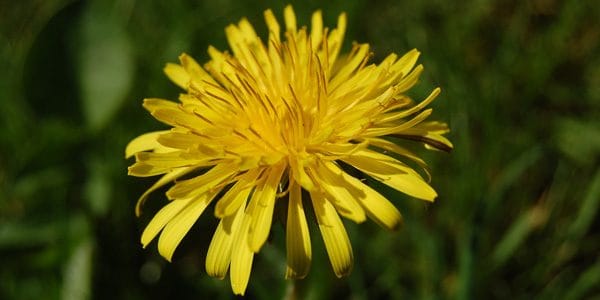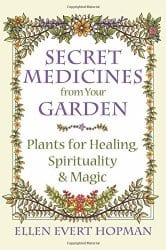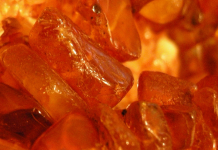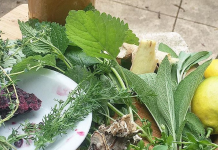
 Secret Medicines from Your Garden: Plants for Healing, Spirituality, and Magic, by Ellen Evert Hopman
Secret Medicines from Your Garden: Plants for Healing, Spirituality, and Magic, by Ellen Evert Hopman
Healing Arts Press, 9781620555576, 384 pp., 2016
In Secret Medicines from Your Garden, master herbalist, Druid priestess, and lore mistress Ellen Evert Hopman shares some of her herbal healing wisdom with her own distinct stamp of individuality, elevating this book above and beyond a simple reference book. What takes shape in these pages is a holistic resource for herbalists comprising herbal lore, recipes, and personal anecdotes, making this an ideal companion for anyone seeking an herbal mentor.
Rather than offering an appendix of herb names and functions (many are present, and the reader can skim them in some parts), readers get to experience them with Hopman as she retells parts of her journey with plants. In this way, the teaching in this book is alive. Herbalist and author Matthew Wood notes in the foreword, “we feel the thread of the writer’s experience and life running through the pages, unifying diverse lessons into a flowing and almost living narrative,”1 and the result is pretty empowering. One gets the sense that this is Hopman’s goal here.
Like herbal healing itself, Secret Medicines from Your Garden instills the reader with a sense of self sufficiency and being supported by the earth. The author, who’s work is testament to this, is clearly committed to her craft and has paved a courageous path for many aspiring herbalists to see. In the introduction, “Walking the Green Path,” Hopman explains a visit to Rome during grad school where she studied art history but “felt a pull to go to the countryside.”2 Following the instruction of a monk, she went to a hillside Franciscan community where she wandered in the wilderness, partook of community baking and community activities for four days. Here, plants called to her, and their voice was so strong it prompted her to “throw out everything [she] was doing.”3 This is when she began working with plants. Reading about her journey inspired me, and reminded me of times I’ve felt a similar pull to change my own path, many of which have been prompted by experiences in nature.
Hopman also shares pieces of advice she received that helped her realize the importance of permission to find one’s own way in a creative healing art like herbalism: “After I studied with the First Nations for five years, one of the elders said to me: ‘It’s great that you are learning the ways and honoring our ancestors. But you need to honor your own.”4 It was then she discovered Druidry, and set out to find other Druids, which adds, of course, a unique depth of value to Hopman’s career as a herbal healer. Plants opened a doorway for Hopman that changed her life and worldview. I don’t doubt that for many who read this book it will open doors to doing the same.
Hopman offers everything the reader needs to start tapping into, and strengthening, their own connection with plants: in part one, “A Wildcrafting Primer,” Hopman reveals how to intuit a plant’s properties based on their form, colour, location and more. For instance, plants that thrive in the shade tend to be cooling, plants with hollow stems will help clean out tubes in the human body, and so on. Not just with woodland herbs, but ones common in cities like dandelion, nettle, tulip, wisteria, and others.
Dandelions, for example, are usually thought to be weeds in cities and suburban areas, but this book shows how they can be used as healing herbs. As well as supporting kidney and liver functions, a small section called “The Energetics of Color,” explains that yellow flowering plants like dandelions can also enhance a sense of personal power. Hopman shares ways to consume dandelion greens (mixed into a salad after being rinsed, or dusting them with flour, salt and pepper and frying in butter), and make dandelion tea from their roots. She also writes that the flowers can be used to make wine. This usage seems way more interesting than my previous experiences using dandelion, which has been limited to buying dried herbs at a bulk store and steeping in hot water and lemon to make a pretty run-of-the-mill dandelion tea.
Will I opt to pick dandelions from my downtown Toronto neighbourhood this spring? Maybe not, but Hopman, who lives in a forest in New England, does share some cautions for urban foragers in this section: “Gather plants at least one thousand feet from a roadway to avoid the pollutants that abound there, such as those from car exhaust and brake lining”5 The next time I find myself in a locale that grows dandelions in abundance one thousand feet from a roadway, I’ll be sure to pick some to try out a fresher tea.
In part 2, “Exploring Invisible Dimensions of the Plant World,” Hopman looks at animal spirit medicines and herbal astrology, and ways to communicate with plants, including topical sprays, singing to plants, and more. In Parts 3 and 4, “Enjoying Nature’s Bounty” and “Formula Making,” Hopman shares bee medicine and kitchen medicine recipes, including oils, salves, incense, bath sachets, cookies (pine gingerbread, anyone?), and teas for physical and spiritual healing. The book ends with a comprehensive table of constitutional prescribing (treatment using herbs, based on the whole person) and a glossary of contraindications (any reasons to not use certain herbs for example, during pregnancy, or for those with heartburn, etc.),
Hopman provides instructions for the “triangle” formula-making system of her mentor, William LeSassier, to help the reader make custom herbal remedies tailored to a person’s unique strengths and weaknesses. She writes that recording this formula and sharing it was one of her major impetuses for writing the book.6 The 18-part system aims to help herbal practitioners design a balanced approach for long-term prescribing, combining cleansing herbs, building herbs, and tonic herbs in the right proportions.
Hopman’s Secret Medicines from Your Garden takes the secrecy out of herbal medicine, and makes it accessible and straightforward for readers of all gardening prowess and healing needs.
Image credit: Clare Bell








